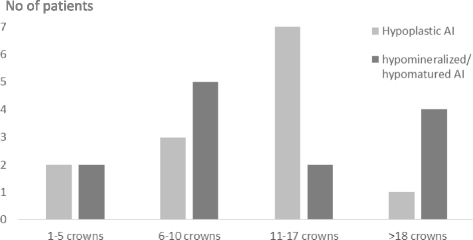Oral health-related quality of life before and after crown therapy in young patients with amelogenesis imperfecta
- PMID: 26651486
- PMCID: PMC4676094
- DOI: 10.1186/s12955-015-0393-3
Oral health-related quality of life before and after crown therapy in young patients with amelogenesis imperfecta
Abstract
Background: Amelogenesis imperfecta (AI) is a rare, genetically determined defect in enamel mineralization associated with poor esthetics and dental sensitivity. Because the condition is associated with negative social outcomes, this study evaluated oral health-related quality of life (OHRQoL), dental fear, and dental beliefs before and after early prosthetic crown therapy for AI during adolescence.
Methods: The study included 69 patients with AI, aged 6-25 yr: 33 males and 36 females (mean age 14.5 ± 4.3); healthy controls (n = 80), patients with cleft lip and palate (CLP; n = 30), and patients with molar incisor hypomineralization (MIH; n = 39). All matched in age and gender, and all but the CLP group insocioeconomic area. Patients completed three questionnaires measuring OHRQoL (OHIP-14), dental fear (CFSS-DS), and dental beliefs (DBS-R). Twenty-six patients with severe AI between ages 9 and 22 yr received crown therapy and completed the questionnaires twice: before and after therapy.
Results: OHIP-14 scores were significantly higher among patients with AI (7.0 ± 6.7), MIH (6.8 ± 7.6) and CLP (13.6 ± 12.1) than healthy controls (1.4 ± 2.4) (p < 0.001). After crown therapy, quality of life problems in the 26 patients with severe AI decreased significantly, from 7.8 ± 6.1 to 3.0 ± 4.8 (p < 0.001). Early prosthetic therapy did not increase dental fear or negative attitudes toward dental treatment.
Conclusions: OHRQoL increased after early crown therapy in patients with severe AI. Therapy did not increase dental fear or negative attitudes toward dental treatment.
Figures




Similar articles
-
The psychosocial impact of developmental dental defects in people with hereditary amelogenesis imperfecta.J Am Dent Assoc. 2005 May;136(5):620-30. doi: 10.14219/jada.archive.2005.0233. J Am Dent Assoc. 2005. PMID: 15966649
-
Crown therapy in young individuals with amelogenesis imperfecta: Long term follow-up of a randomized controlled trial.J Dent. 2018 Sep;76:102-108. doi: 10.1016/j.jdent.2018.06.020. Epub 2018 Jul 9. J Dent. 2018. PMID: 30004001 Clinical Trial.
-
Impact of moderate and severe hypodontia and amelogenesis imperfecta on quality of life and self-esteem of adult patients.J Dent. 2013 Aug;41(8):689-94. doi: 10.1016/j.jdent.2013.06.004. Epub 2013 Jun 15. J Dent. 2013. PMID: 23778130
-
Advances in clinical diagnosis and management of amelogenesis imperfecta in children and adolescents.J Dent. 2024 Aug;147:105149. doi: 10.1016/j.jdent.2024.105149. Epub 2024 Jun 21. J Dent. 2024. PMID: 38909645 Review.
-
Patient-reported outcome measures in individuals with amelogenesis imperfecta: a systematic review.Eur Arch Paediatr Dent. 2022 Dec;23(6):885-895. doi: 10.1007/s40368-022-00737-3. Epub 2022 Jul 27. Eur Arch Paediatr Dent. 2022. PMID: 35896941 Free PMC article.
Cited by
-
Public and dental professionals' use of social media to discuss amelogenesis imperfecta.Int J Paediatr Dent. 2022 Nov;32(6):903-914. doi: 10.1111/ipd.13015. Epub 2022 Jul 18. Int J Paediatr Dent. 2022. PMID: 35771161 Free PMC article.
-
Changes in oral health-related quality of life before and after dental treatment in 8-12-year-old Costa Rican schoolchildren.Front Dent Med. 2023 Apr 27;4:1167845. doi: 10.3389/fdmed.2023.1167845. eCollection 2023. Front Dent Med. 2023. PMID: 39916896 Free PMC article.
-
Tooth ultrastructure changes induced by a nonsense mutation in the FAM83H gene: insights into the diversity of amelogenesis imperfecta.Clin Oral Investig. 2023 Oct;27(10):6111-6123. doi: 10.1007/s00784-023-05228-3. Epub 2023 Aug 24. Clin Oral Investig. 2023. PMID: 37615776
-
[Rare diseases and their clinical oral manifestations in two Hospitals in Yaoundé].Pan Afr Med J. 2019 Apr 22;32:195. doi: 10.11604/pamj.2019.32.195.14684. eCollection 2019. Pan Afr Med J. 2019. PMID: 31312307 Free PMC article. French.
-
Vital bleaching for children with dental anomalies: EAPD members' survey.Eur Arch Paediatr Dent. 2020 Oct;21(5):565-571. doi: 10.1007/s40368-019-00494-w. Epub 2019 Nov 29. Eur Arch Paediatr Dent. 2020. PMID: 31784871 Free PMC article.
References
Publication types
MeSH terms
LinkOut - more resources
Full Text Sources
Other Literature Sources
Medical
Miscellaneous

